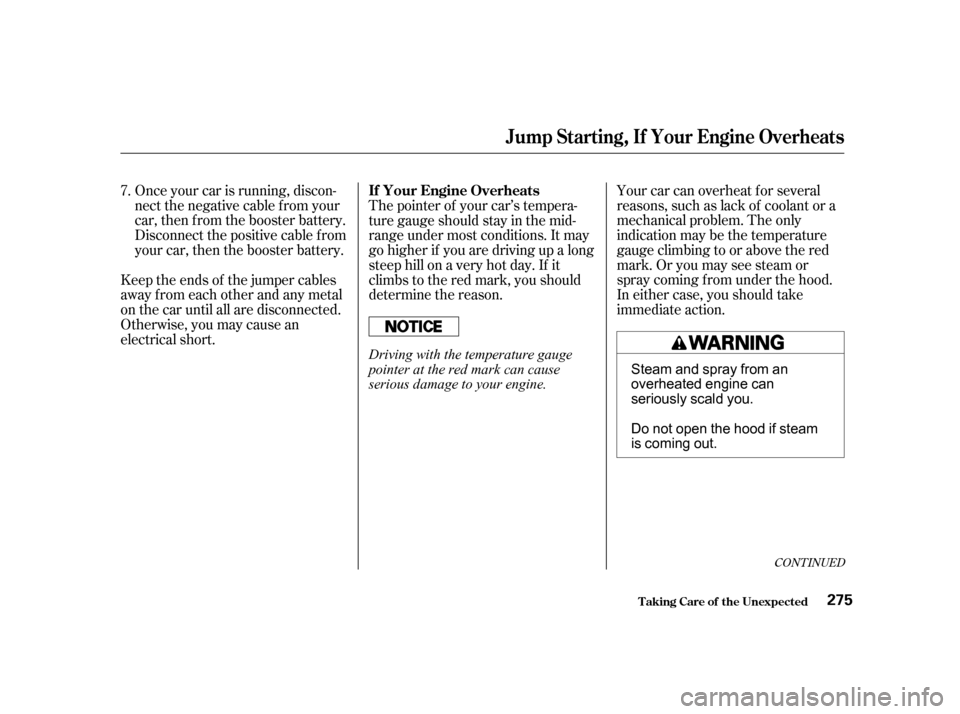Page 277 of 325
�µ
�´
�´
Connect the second jumper cable
to the negative ( ) terminal on
the booster battery. Connect the
other end to the grounding strap
as shown. Do not connect this
jumper cable to any other part of
the engine.
If the booster battery is in another
vehicle, have an assistant start
that vehicle and run it at a fast idle. Start your car. If the starter motor
still operates slowly, check the
jumper cable connections to make
sure they have good metal-to-
metal contact.
Connect one jumper cable to the
positive ( ) terminal on your
Honda’s battery. Connect the
other end to the positive ( )
terminal on the booster battery.
3.
4.6.
5.
Jump Starting
T aking Care of t he Unexpect ed274
B BO OO OSSTTE
ER
R B
BAA T
TT
TE
ER
RY Y
Page 278 of 325

Once your car is running, discon-
nectthenegativecablefromyour
car, then from the booster battery.
Disconnect the positive cable f rom
your car, then the booster battery.Your car can overheat f or several
reasons, such as lack of coolant or a
mechanical problem. The only
indication may be the temperature
gauge climbing to or above the red
mark. Or you may see steam or
spray coming f rom under the hood.
In either case, you should take
immediate action.
The pointer of your car’s tempera-
ture gauge should stay in the mid-
range under most conditions. It may
go higher if you are driving up a long
steep hill on a very hot day. If it
climbs to the red mark, you should
determine the reason.
Keep the ends of the jumper cables
away from each other and any metal
on the car until all are disconnected.
Otherwise, you may cause an
electrical short. 7.
CONT INUED
If Your Engine Overheats
Jump Starting, If Your Engine Overheats
T aking Care of t he Unexpect ed275
Steam and spray from an
overheated engine can
seriously scald you.
Do not open the hood if steam
is coming out.
Driving with the temperature gauge
pointer at the red mark can cause
serious damage to your engine.
Page 282 of 325
This indicator should come on when
the ignition switch is ON (II), and go
out af ter the engine starts. If it
comes on brightly when the engine
is running, it indicates that the
charging system has stopped
charging the battery.By eliminating as much of the
electrical load as possible, you can
drive several miles (kilometers)
before the battery is too discharged
to keep the engine running. Drive to
a service station or garage where
you can get technical assistance.
Immediately turn of f all electrical
accessories: radio, heater, A/C, rear
def ogger, cruise control, etc. Try not
to use other electrically-operated
controls such as the power windows.
Keep the engine running and take
extra care not to stall it. Starting the
engine will discharge the battery
rapidly.
Charging System Indicator
T aking Care of t he Unexpect ed279
C CH
H A
AR
RGGI INNG G S
SYYSSTTE
EM
M I
INND DI
ICCA A T
TO
OR R
Page 284 of 325
Your car has certain ‘‘readiness
codes’’ that are part of the on-board
diagnostics f or the emissions
systems. In some states, part of the
emissions testing is to make sure
these codes are set. If they are not
set, the test cannot be completed.
If your car’s battery has been
disconnected or gone dead, these
codes are erased. It takes several
days of driving under various
conditions to set the codes again.If possible, do not take your car f or a
state emissions test until the
readiness codes are set. To check if
they are set, turn the ignition ON (II),
but do not start the engine. The
Malf unction Indicator Lamp will
come on f or 20 seconds. If it then
goes of f , the readiness codes are set.
If it blinks 5 times, the readiness
codes are not set. See State
Emissions Testing on page .
301
Readiness Codes
Malf unction Indicator L amp
T aking Care of t he Unexpect ed281
Page 290 of 325
�µ
�µ
�µ
Amps.
No. Circuits Protected
CONT INUED
20 A
15 A
7.5 A 20 A
10 A
15 A
15 A
20 A
10 A
40 A
30 A
40 A
40 A
40 A
15 A
20 A
15 A
80 A
40 A
1
2
3
4
5
6
7
8
9
10
11
12
13
14
15
16
17
18
19
20 Condenser Fan
Small Light
Interior Light
Cooling Fan
Hazard
FI ECU
Horn Stop
ABS F/S
Back Up
ABS Motor
Rear Defroster
Heater Motor
Power Window
Option
Lef t Headlight
Door Lock
Right Headlight
Not Used
Battery
Ignition 1
Spare Fuses
21 25
Fuses
T aking Care of t he Unexpect ed287
UNDER-HOOD FUSE BOX
Page 293 of 325
If you decide to tow your car with all
f our wheels on the ground, make
sure you use a properly-designed and
attached tow bar. Prepare the car for
towing as described above, and leave
the ignition switch in Accessory (I)
so the steering wheel does not lock.
Make sure the radio and any items
plugged into the accessory power
socket are turned of f so they do not
rundownthebattery.
With the f ront wheels on the ground,
it is best to tow the car no farther
than 50 miles (80 km), and keep the
speedbelow35mph(55km/h).
If your car is equipped with a f ront
spoiler, remove it bef ore towing so it
is not damaged.
Emergency Towing
T aking Care of t he Unexpect ed290
Trying to lif t or tow your car by the
bumpers will cause serious damage.
The bumpers are not designed to
support the car’s weight.
The steering system can be damaged if
the steering wheel is locked. Leave the
ignition switch in Accessory (I), and
make sure the steering wheel turns
f reely bef ore you begin towing.
Page 298 of 325

�µ�µ�µ
�µ�µ
�Î
�Î �µ
�µ
�µ
�µ
�µ
�µ
�µ
�µ
�µ
�µ
�µ
�µ
�µ
�µ
�µ
�Î
�Î
�Î
�Î
�Î
�Î �Î
�Î
�Î
�Î
Specif ications
T echnical Inf ormation295
Battery Fuses
Tires Alignment
Air Conditioning
Lights
HFC-134a (R-134a)
17.6 19.4 oz (500 550 g) SP-10
12 V
12 V 60/55 W (HB2)
21/5 W
60 psi (420 kPa , 4.2 kgf/cm
)
12 V 5 W 12 V 8 W
12 V 5 W
12 V 5 W
12 V 8 W
12 V 5 W
12 V 21 W
12 V 3 CP
12 V 21 W 12 V 21/5 W 12 V 21 W
12 V 3 CP
12 V 36 AH/5 HR
Capacity Interior
Under-hood
Size
Pressure Toe-in
Camber
Caster
1°33’45’
0°
0.00 in (0.0 mm)
30 psi (210 kPa , 2.1 kgf/cm)
T115/70D14 88M
P185/65R15 86HP185/70R14 87S
Refrigerant type
Charge quantity
Lubricant oil type
See page
285or the fuse label
attached to the inside of the fuse
box door under the steering
column.
See page 284or the fuse box
cover.
0.08 in ( 2.0 mm)
T125/70D15 95M
Headlights (HI/LO)
Front turn signal/side marker
lights
Front parking light
Rear turn signal lights
Stop/Taillights/Rear side
marker lights
Back-up lights
Taillights
High-mount stop light
License plate lights
Ceiling light
Front ceiling light
Spotlights
Trunk light
Front
Rear
Front
Rear
Front
1: EX
2: LX Front/Rear
Spare
Front/Rear
Spare
1:
2:
3: U.S.: DX, HX and LX
Canada: DX, LX
U.S.: EX
Canada: Si
U.S.: EX and LX with ABS
Canada: Si
ABS equipped models (DX, LX)
1
1
2 1
2
1
3
Page 306 of 325

CONT INUED
If the testing f acility determines that
the readiness codes are not set, you
will be requested to return at a later
date to complete the test. If you must
get the vehicle re-tested within the
next two or three days, you can
condition the vehicle for re-testing
by doing the f ollowing.Make sure the gas tank is nearly,
but not completely, f ull (around
3/4).
Make sure the vehicle has been
parked with the engine of f f or 8
hours or more.
Make sure the ambient
temperature is between 20° and
95°F. Without touching the accelerator
pedal, start the engine and let it
idle f or 20 seconds.
Keep the vehicle in Park
(automatic transmission) or
Neutral (manual transmission).
Increase the engine speed to 2,000
rpm and hold it there until the
temperature gauge rises to at least
1/4of thescale(approximately3
minutes).
If you take your vehicle f or a state
emissions test shortly af ter the
battery has been disconnected or
gone dead, it may not pass the test.
This is because of certain ‘‘readiness
codes’’ that must be set in the on-
board diagnostics f or the emissions
systems. These codes are erased
when the battery is disconnected,
and set again only after several days
of driving under a variety of
conditions.
T echnical Inf ormation
St at e Emissions T est ing
T esting of Readiness Codes
303